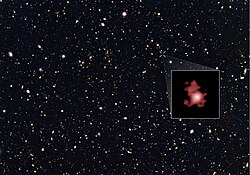Overview
The event was discovered on 22 February 2016 by the Panoramic Survey Telescope and Rapid Response System (Pan-STARRS) in Hawaii, [7] with follow-up observations by the Hubble Space Telescope. The supernova occurred at a high z-value indicating a distance of 3.6 billion light-years. [8] and is located in the constellation Draco. [9] The maximum apparent magnitude was 18.11, the corresponding absolute magnitude −22.35. [10]
The progenitor star is estimated to have had at least 50 to 100 solar masses. The spectrum of SN 2016aps revealed significant amounts of hydrogen, which is unexpected for supernovae of this type, which usually occur after nuclear fusion has consumed most of the star's hydrogen and the stars have shed the remaining hydrogen atmosphere. This led researchers to the theory that the progenitor star formed only shortly before the event from the merger of two very large stars, creating a "pulsational pair instability" supernova or possibly a full pair instability supernova. [11] [8] [12]
This page is based on this
Wikipedia article Text is available under the
CC BY-SA 4.0 license; additional terms may apply.
Images, videos and audio are available under their respective licenses.



